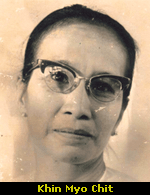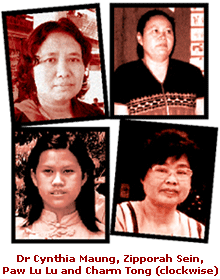Burma’s long tradition of principled and influential leadership by women carries on in the work of activists and social workers in exile
The New Light of Myanmar, the Burmese junta’s main mouthpiece, recently reported on a meeting of the Myanmar [Burma] Women’s Affairs Federation to celebrate this year’s Myanmar Women’s Day. During the meeting, members of the pro-junta group denounced opposition icon Aung San Suu Kyi, winner of the 1991 Nobel Peace Prize, as a destabilizing force and someone who “has done nothing good for the nation.” The meeting ended with the chanting of slogans.
 Such is the sad state of women’s affairs in Burma, where an internationally-renowned woman of courage and conviction languishes under house arrest, while the junta pressures others to make scripted accusations and sing political slogans. It was not always so. Throughout history, Burmese women have played active and influential roles in Burma’s national and political life.
Such is the sad state of women’s affairs in Burma, where an internationally-renowned woman of courage and conviction languishes under house arrest, while the junta pressures others to make scripted accusations and sing political slogans. It was not always so. Throughout history, Burmese women have played active and influential roles in Burma’s national and political life.
Burmese historical chronicles such as the Taungdwingyi recount tales of the Panhtwa Princess who ruled the ancient city of Beikthano before its destruction in the fifth century BC. Other historical chronicles—the Yazawingyi, Yazawinlat, and The Glass Palace Chronicle—tell of Queen Nam Hkam, also known as Malasandi, who reigned in Thagya-in, now Sri Kshetra, another center of ancient Pyu civilization. Local legend has it that a Queen Kywaypi reigned in Arakan State in the 3rd century AD.
Other women are known to have played vital roles in Burma’s imperial past. In the mid 15th century, Queen Shin Saw Bu—daughter of King Razadarit and an important ruler of the Hongsawaddy dynasty (1453-1472) in her own right—donated her weight in gold for use in the first gilded coating applied to Shwedagon Pagoda in Rangoon.
Not all of Burma’s influential women were so respected or compassionate. Although judged far more harshly by history than Shin Saw Bu, the controversial and vicious Supayalat, Burma’s last queen, had enormous influence in the political and social affairs of the Mandalay palace before the fall of King Thi Baw to British colonial forces in 1885. Some historians claim that she, and not her reputedly gin-loving husband King Thi Baw, ruled Upper Burma until the British annexation.
During colonial times, the writer Khin Myo Chit, author of Colorful Burma, was at the forefront of anti-colonial demonstrations in 1938. In one instance, while carrying a red flag at the head of a group of demonstrators, she appealed to Burmese women to “show your hereditary pride and courage.” She was badly beaten by police in front of colonial administration buildings in Rangoon but went on to deliver relief supplies and medicine to detained demonstrators.
“Daw Khin Myo Chit showed the way for our women to recognize our rights,” says writer May Nyein, who now lives in exile in Thailand. “She encouraged our women not to give up.”
Recognized for her community work in colonial-era Burma, Saw Hsa won the prestigious British civil award Member of the British Empire (MBE). She studied in Ireland, graduating in medicine, and attended numerous international conferences. In 1937 she became a member of the new Burma Senate.
 In the early years of Burma’s independence, several women played prominent roles in public life. Appointed by U Nu in 1953 to represent Karen State, Ba Maung Chein became the first and only Burmese woman to receive a cabinet-level position in the Burmese government.
In the early years of Burma’s independence, several women played prominent roles in public life. Appointed by U Nu in 1953 to represent Karen State, Ba Maung Chein became the first and only Burmese woman to receive a cabinet-level position in the Burmese government.
Perhaps the most influential woman of this period was Suu Kyi’s mother, Khin Kyi, chairman of the Women’s Association of Burma, who went on to build a successful career as a diplomat. In 1960 she was appointed Burma’s Ambassador to India, with special responsibility also for Nepal.
Khin Kyi was showered with international awards during her career. The US, Yugoslavia and Thailand all awarded her honors, while at home she won the Maha Thiri Thudhamma prize, given for services to Burmese social and religious life.
Ne Win’s military coup in 1962 curtailed, but did not entirely exclude, the involvement of women in affairs of state. Under Burmese Socialist Programme Party rule (1962-1988), nine women were elected to the first Pyithu Hluttaw, or People’s Assembly. In the subsequent election, that number rose to 14.
Veteran Burmese writer Daw Amar, now 89, won Burma’s Sarpay Beikman literature award for her book The Artists Whom People Love. She is still an outspoken champion of democracy and human rights.
As Burma now suffers under the stranglehold of yet another incompetent and oppressive military regime, Burmese women in exile have assumed the mantle of activism that is denied to so many at home.
Suu Kyi is certainly the most outstanding of the many Burmese women who have helped to draw the international spotlight on Burma in recent years. Now four other names can be added to the ranks. Dr Cynthia Maung, human rights activists Charm Tong and Zipporah Sein, and refugee worker Paw Lu Lu, are among 1,000 women worldwide nominated jointly by a Swiss movement for this year’s Nobel Peace Prize.
Cynthia Maung is a Karen medical doctor who runs a clinic for Burmese migrants, refugees and orphans in Mae Sot, on the Thailand-Burma border. In 1999 she was the first to win the US-sponsored Jonathan Mann award. The Philippines also honored her in 2002 with the Ramon Magsaysay award for community leadership. Time magazine listed her in its April 2004 issue as one of its cover story “Asian Heroes.”
Brought up in northern Thailand, Charm Tong, 23, became involved at an early age with human rights work. At 16, she joined the Shan Human Rights Foundation, and two years later she helped to found the Shan Women’s Action Network, which made headlines in 2002 by releasing a report documenting rapes committed by Burmese soldiers against ethnic minority women in Shan State. During the past five years she has traveled widely, speaking on Shan human rights issues. She won international recognition in 2004 as one of Marie Claire magazine’s “women of the world,” and in March she received Reebok’s human rights award.
Zipporah Sein is the general secretary of the Karen Women’s Organization, for whom she has worked since 1985, and, like Charm Tong, an energetic worker for human rights. Zipporah Sein has focused her advocacy work on the rights of women and children and has contributed to numerous conferences on women’s rights and democratic reform in Burma.
Paw Lu Lu has managed a “safe house” on the Thai-Burma border in Kanchanaburi province since 1993. She established the sanctuary with the help of her husband and son, and though most of her residents are Burmese, others hail from Cambodia, Malaysia and China. Among other services, Paw Lu Lu provides vocational training in areas such as weaving and sewing, and also cares for more than 100 HIV/AIDS patients.
Significantly, the junta has no names of its own to add to Burma’s list of outstanding women, not even in the political sphere. Under Rangoon’s junta, the role of women in Burmese public life has been progressively whittled down to a token collection of distaff organizations.
In the spirit of Khin Myo Chit, who urged her fellow women “to show your hereditary pride and courage,” women of profound conviction, such as the Burmese women nominated for this year’s Nobel Peace Prize, struggle against overwhelming challenges to reclaim dignity and justice for their homeland, as the Burmese women of past generations did.

 Such is the sad state of women’s affairs in
Such is the sad state of women’s affairs in  In the early years of
In the early years of